#A test of combining 3D and 2D
Photo
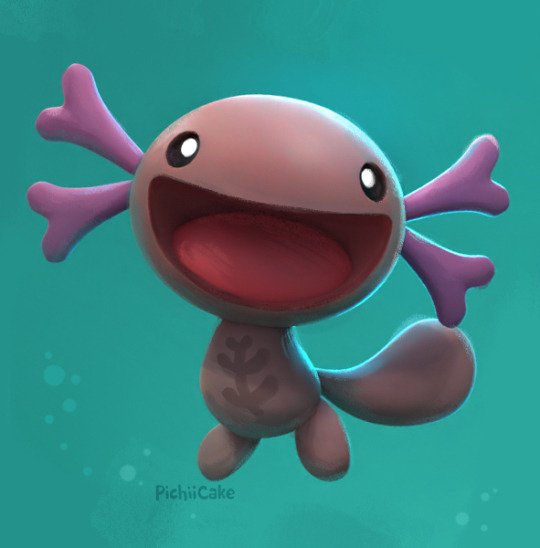
#Paldean wooper#pokemon#wooper#scarlet and violet spoilers#spoilers#I love the woop - they're always so happy and derpy!#A test of combining 3D and 2D
646 notes
·
View notes
Photo

Little test combining 2d character in a 3d background !
2K notes
·
View notes
Text

Baji Jin - The Power of Baji Quan
Baji Quan is a martial art focused on power and strength, emphasizing the method of generating force. Wutan magazine once illustrated three types of Baji Quan power. I want to add my perspective, hoping it complements the original content.
In this article, I use "Jin," a refind force, to represent the original meaning of the Chinese language instead of the word "Li" or force in English. The Jin in Baji Quan originates from the training tec… See more
Baji Jin - The Power of Baji Quan
Baji Quan is a martial art focused on power and strength, emphasizing the method of generating force. Wutan magazine once illustrated three types of Baji Quan power. I want to add my perspective, hoping it complements the original content.
In this article, I use "Jin," a refind force, to represent the original meaning of the Chinese language instead of the word "Li" or force in English. The Jin in Baji Quan originates from the training techniques of the bear and tiger forms. The bear represents a sinking Jin emphasizing vertical action (force exerted downward into the ground and its reaction upward). The tiger represents a cross Jin, which channels the force drawn from the ground through the legs, waist, hips, back, and shoulders and directs it along the spatial XYZ axes (Please note that this is a 3D, not 2D cross) to issue power. The combination of these two Jins creates the silk-reeling Jin.
In traditional martial arts, the silk-reeling Jin is predominantly used for striking targets. It can move steadily and accurately in a specific direction through the air. When it contacts a target, the silk-reeling Jin can be divided into two types: long Jin and short Jin. From a physics perspective, long Jin operates over a longer distance with intense penetration but takes more time; it is just like a straight stroke in billiards. Short Jin, also known as inch Jin (originating from the Northern Chinese accent term "crisp Jin"), operates over a short distance with instantaneous explosiveness, resembling a draw stroke in billiards.
For the bear form, beginners must practice stomping because it requires deeply sinking the center of gravity into the ground. For the tiger form, practicing bow/arrow and horse stance strikes is essential to generate Jin in all directions. To integrate the bear and tiger forms into the silk-reeling Jin, practitioners often use dragging and grinding steps while punching to experience the power.
Why use dragging and grinding steps to practice the silk-reeling Jin? I think static training alone is insufficient; true silk-reeling Jin is achieved through dynamic movement. Another renowned martial art from Wutan is the Bagua Palm, founded by Great Master Gong Bao Tian. Bagua is famous for saying, "The palm is not just the palm; the whole body is the palm." Bagua is known for its dynamic steps, emphasizing the integration of hands, eyes, body, and steps to form a spiral Jin, also known as silk-reeling Jin.
Imagine a beginner playing table tennis confined to the table surface. At the same time, the pro uses their entire body to control the ball, moving with butterfly-like steps in all directions, turning the space around the table into their battlefield. Their advanced skills are often awe-inspiring. This is the all-encompassing silk-reeling Jin.
Baji Quan training at Wutan consists of three stages:
1. Xiao Baji Quan (Small Baji Quan) establishes the foundation by displaying the three types of Jin everywhere and using grinding and dragging steps to enhance the "semi-dynamic" silk-reeling Jin.
2. Da Baji Quan (Large Baji Quan): This stage explores the technique with dynamic steps, particularly the lifting and changing steps. The "fully dynamic" silk-reeling Jin is vividly demonstrated at this stage.
3. Liu Da Kai (Six Major Openings): Advanced tests of the learned techniques. Without a solid foundation in the three Jins, coupled with the agility acquired through paired practice and sparring, and the ability to flexibly use long and short silk-reeling Jins to adjust distance, angle, height, and timing, it is challenging to effectively defeat an opponent with Baji Quan. The sinking Jin and cross Jin combine to form the silk-reeling Jin, the core of Baji Quan techniques.
These are my humble insights on training Baji Quán and its power generation. I hope they inspire further input to improve our training methods.
Octopus
Eight-pole is a power boxing, pay attention to how to put it. Wushu magazine has listed three kinds of octopus kungfu drawings. Now I’m adding personal opinion, hopefully not dog tail 貂.
In this article I use " 勁" to represent the original meaning of Chinese instead of "force". The eight-pole fist starts from the two-shaped exercises of the bear and tiger. The bear is stressed up and down (the force goes down to the ground while the reaction is up), the tiger is the cross is the force drawn from the ground through the legs, the waist, the back and the shoulder, the three-dimensional XYZ direction, and the two-hills are the silk. Traditional martial arts strikes are almost always targeted by silk silk, which is stable and accurate in the air in a specific direction. When contact with the target, silk silk can be divided into two types: Long and short beams: according to the physics impulse principle, long work distance, strong penetration, but also long time, such as the straight of a pool ball. The short lizard, also known as the crunch of the northern Chinese accent, is short working distance and instantaneous bursts, and has the characteristics of a recurring momentum, such as the pull of a pool ball.
The bear shape requires the center of gravity to sink down to three feet, so beginners have to practice the beard. Tiger shape needs to be put up and down and left, so bow and horse-style paw or taek are essential. Practicing bear and tiger two-tiger silk silk, often experienced by dragging and pacing boxing. Why do you use drag steps to practice silk? My opinion is that it's not enough to have fixed training, real silk must be done by living steps.
Another watchman of martial arts in the martial arts of the martial arts is the palms of the palace master. There is a well-known saying in the gossip: "No hand is the palm, the whole Gossip is famous for its live steps, emphasizing that hand-eye steps together to form propellers, that is, silk silk. Imagine a beginner playing ping-pong is limited to the face, while a master uses his whole body force to control the ball. He uses a flower butterfly-like footwork, turning the space near the face into his battlefield. The superb technique is often amazing. That's the full range of silk.
There are three stages of training in martial arts:
1. 1. Little octopus shows these three kinds of cunning everywhere and steps and drags to strengthen the "semi-dynamic" silk.
2. The Big 8 Pole Fist is a move to live, especially to change steps. At this point the "full dynamic" silk is showing up alive.
3. 3. The six great opening art is the true test of the technology learned. Without a deep three-pole foundation, plus quick hand-eye steps from playing against the pair, and flexible use of the length and length of the silk to adjust the distance angle and grasp the timing of the hair, the low level of octopus is not easy to destroy the enemy. In short, the combination of dullness and cross-healing forms the silk silk, and the silk silk is the core of the octopus art.
The above is my little careful about the eight pole practice, hope there will be a reverberation of the jade.
#sifu kisu#atlab#lok#northern shaolin#northern shaolim#kung fu#jian#atlab lok#baguazhang#piandao#Baji kung fu
19 notes
·
View notes
Text
Hell is terms like ASIC, FPGA, and PPU
I haven't been doing any public updates on this for a bit, but I am still working on this bizarre rabbit hole quest of designing my own (probably) 16-bit game console. The controller is maybe done now, on a design level. Like I have parts for everything sourced and a layout for the internal PCB. I don't have a fully tested working prototype yet because I am in the middle of a huge financial crisis and don't have the cash laying around to send out to have boards printed and start rapidly iterating design on the 3D printed bits (housing the scroll wheel is going to be a little tricky). I should really spend my creative energy focusing on software development for a nice little demo ROM (or like, short term projects to earn money I desperately need) but my brain's kinda stuck in circuitry gear so I'm thinking more about what's going into the actual console itself. This may get techie.
So... in the broadest sense, and I think I've mentioned this before, I want to make this a 16-bit system (which is a term with a pretty murky definition), maybe 32-bit? And since I'm going to all this trouble I want to give my project here a little something extra the consoles from that era didn't have. And at the same time, I'd like to be able to act as a bridge for the sort of weirdos who are currently actively making new games for those systems to start working on this, on a level of "if you would do this on this console with this code, here's how you would do it on mine." This makes for a hell of a lot of research on my end, but trust me, it gets worse!
So let's talk about the main strengths of the 2D game consoles everyone knows and loves. Oh and just now while looking for some visual aids maybe I stumbled across this site, which is actually great as a sort of mid-level overview of all this stuff. Short version though-

The SNES (or Super Famicom) does what it does by way of a combination of really going all in on direct memory access, and particularly having a dedicated setup for doing so between scanlines, coupled with a bunch of dedicated graphical modes specialized for different use cases, and you know, that you can switch between partway through drawing a screen. And of course the feature everyone knows and loves where you can have one polygon and do all sorts of fun things with it.
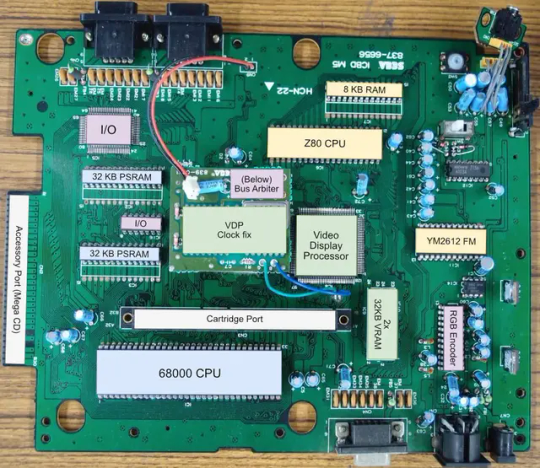
The Genesis (or Megadrive) has an actual proper 16-bit processor instead of this weird upgraded 6502 like the SNES had for a scrapped backwards compatibility plan. It also had this frankly wacky design where they just kinda took the guts out of a Sega Master System and had them off to the side as a segregated system whose only real job is managing the sound chip, one of those good good Yamaha synths with that real distinct sound... oh and they also actually did have a backwards compatibility deal that just kinda used the audio side to emulate an SMS, basically.

The TurboGrafix-16 (or PC Engine) really just kinda went all-in on making its own custom CPU from scratch which...we'll get to that, and otherwise uh... it had some interesting stuff going on sound wise? I feel like the main thing it had going was getting in on CDs early but I'm not messing with optical drives and they're no longer a really great storage option anyway.
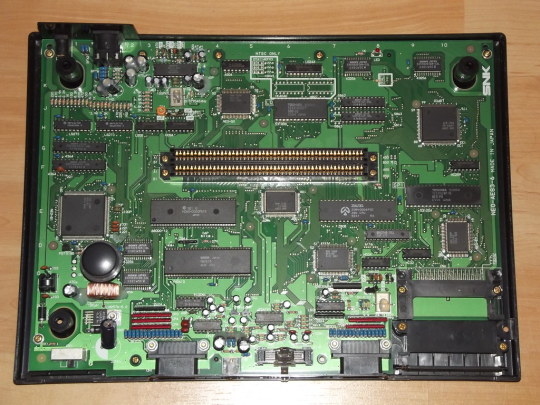
Then there's the Neo Geo... where what's going on under the good is just kind of A LOT. I don't have the same handy analysis ready to go on this one, but my understanding is it didn't really go in for a lot of nice streamlining tricks and just kinda powered through. Like it has no separation of background layers and sprites. It's just all sprites. Shove those raw numbers.
So what's the best of all worlds option here? I'd like to go with one of them nice speedy Motorolla processors. The 68000 the Genesis used is no longer manufactured though. The closest still-in-production equivalent would be the 68SEC000 family. Seems like they go for about $15 a pop, have a full 32-bit bus, low voltage, some support clock speeds like... three times what the Genesis did. It's overkill, but should remove any concerns I have about having a way higher resolution than the systems I'm jumping off from. I can also easily throw in some beefy RAM chips where I need.
I was also planning to just directly replicate the Genesis sound setup, weird as it is, but hit the slight hiccup that the Z80 was JUST discontinued, like a month or two ago. Pretty sure someone already has a clone of it, might use that.
Here's where everything comes to a screeching halt though. While the makers of all these systems were making contracts for custom processors to add a couple extra features in that I should be able to work around by just using newer descendant chips that have that built in, there really just is no off the shelf PPU that I'm aware of. EVERYONE back in the day had some custom ASIC (application-specific integrated circuit) chip made to assemble every frame of video before throwing it at the TV. Especially the SNES, with all its modes changing the logic there and the HDMA getting all up in those mode 7 effects. Which are again, something I definitely want to replicate here.
So one option here is... I design and order my own ASIC chips. I can probably just fit the entire system in one even? This however comes with two big problems. It's pricy. Real pricy. Don't think it's really practical if I'm not ordering in bulk and this is a project I assume has a really niche audience. Also, I mean, if I'm custom ordering a chip, I can't really rationalize having stuff I could cram in there for free sitting outside as separate costly chips, and hell, if it's all gonna be in one package I'm no longer making this an educational electronics kit/console, so I may as well just emulate the whole thing on like a raspberry pi for a tenth of the cost or something.
The other option is... I commit to even more work, and find a way to reverse engineer all the functionality I want out with some big array of custom ROMs and placeholder RAM and just kinda have my own multi-chip homebrew co-processors? Still PROBABLY cheaper than the ASIC solution and I guess not really making more research work for myself. It's just going to make for a bigger/more crowded motherboard or something.
Oh and I'm now looking at a 5V processor and making controllers compatible with a 10V system so I need to double check that all the components in those don't really care that much and maybe adjust things.
And then there's also FPGAs (field programmable gate arrays). Even more expensive than an ASIC, but the advantage is it's sort of a chip emulator and you can reflash it with something else. So if you're specifically in the MiSTer scene, I just host a file somewhere and you make the one you already have pretend to be this system. So... good news for those people but I still need to actually build something here.
So... yeah that's where all this stands right now. I admit I'm in way way over my head, but I should get somewhere eventually?
11 notes
·
View notes
Text
Lelani's Portfolio 2024
3D Jake Adventure Time model (textured, modelled by me)
Character design for Cartoon Network Ident
Handpainted textures for assets
3D Assets for CN Ident
Adventure Time Ident for CN - I was responsible for texturing of every 3D asset, modelling Jake and other assets, 3D animating the eyes, making pixel art portraits, concept art and character design
Character Design for BA project
Concept art (left) and texturing test (right) (model not by me) for BA project
Character design for sushi cat
Concept sketches for sushi restaurant/food cart
Sushi Cart design
3D model of sushi cart, Sushi illustrations
working game assets (toothgems) for Sims 4
working game assets (nails) for Sims 4
Personal Artwork. Sailor Bunny
Personal Artwork. Turnaround for Mushroom cat
Personal Artwork. Portraits.
Personal Artwork. Portraits.
Personal Artwork. portrait (left), Study of the Grand Budapest Hotel (right)
Figure Drawings
Experimental Animation. I've sewn multiple fabric patches and animated those, combined with 2D animation.
#animation#artists on tumblr#artwork#digital art#digital illustration#digital painting#drawing#painting
5 notes
·
View notes
Note
Hi!! I follow your dsmp account and I'm a big fan of your tommygotchi game (it got me through a few plane rides which positively terrify me). I'm a programmer but unfamiliar with game development, and I'm curious as to how you got started/what software you use, if you're comfortable sharing. Thank you!!
Hello! i'm very happy to hear that something I've made has helped you out!
Technically I started out mindlessly following GameMaker 2004 tutorials on youtube when I was around 10 but really got into the meat of it with RPG Maker, and by pure will of wanting to make something, I ended up learning and using a bunch of software along the way.
I usually reccomend RPG Maker for starting out, but I think being a programmer could really put you in more intermediate software.
I used GameMaker 2 to make most of my games, It has a language similar to Java and C, but also has a lot of pre-made blocks for begginers, kinda like scratch!
Although! to make things even easier, I reccomend finding software thats solely dedicated to the type of game you want to make
Software like GameMaker, Unreal Engine, LÖVE, Godot (which is what im currently using) are very good when you want complete free will and control over your game, which is great if you want to combine genres or make something more complicated, with the downside that is very code heavy and you must make everything from zero.
But! If your vision is a type of game, say, Visual Novel, RPG horror, Fighting game, Point and click adventure, Text adventure, etc. Then using a software that specializes on that will make everything easier and faster, also, it's usually cheaper or free.
I reccomend searching up the community around a software, if it doesn't have one or noone says much about it thats a RED FLAG!! do not be fooled into buying something that will leave you unsatisfied!!
Also, most of what I named here are for 2D games, if you want to get into 3D, then that's usually more code heavy (and money heavy)
Something you can do to test out the software is making a simple already-made game, Like, Try a brick breaking game, space invaders,dress up games, that one petting game i made, something easy to see how the software works.
Specially reccomend to not start right away with the game of your dreams! gain experience by making smaller, simpler games first. You dont even have to publish them!
(GameMaker is a bit of a greedy bitch when it comes to Porting but u didnt hear that from me)
Ok this is long enough already, hope this helps!
#and i still have more to say hot damn#the most important aspect of game developing is commitment! never give up never back down!#change da world. my final message. goodbye
5 notes
·
View notes
Text
Capturing the ambience of Virtua Fighter 3
This popular fighter was revised a few times before being expanded and released as VF 3 Team Battle on both Arcade and Dreamcast. We'll use the Supermodel emulator to run the former version, as it offers superior visuals and sound.
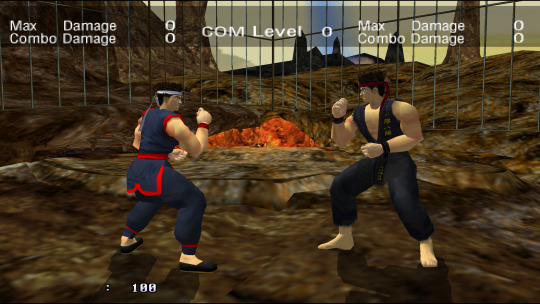
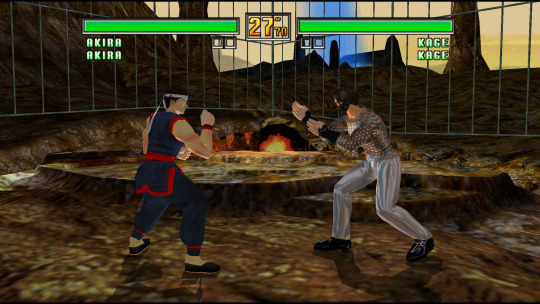
Disabling music
What ultimately worked was a secret button combination: hold Start just before the stage loads, during 2-player matches. The required timing is somewhat tricky; it helps to stagger two presses across your controllers.
Alternatively you can visit stages with Dreamcast's practice mode, where music is always disabled. But as mentioned earlier, I found that Arcade offers higher-quality audio.
VF3 official soundtrack
The official soundtrack also uses a few seconds of ambience to introduce each stage track. In fact, it features some stage sounds not audible in-game (only in Sound Test) such as drips on Cave and creaks on Raft.
Hiding the HUD: Supermodel
For a robust solution, we can modify Supermodel's rendering code. Inside CRender2D::PreRenderFrame, introduce logic such that we don't draw layer 0 inside the Above3D rendering section.
Also, while you're inside the code, ensure layer 3 is skipped inside CNew3D::SkipLayer. This avoids drawing this strange red triangle:

Hiding player-characters
I discovered that Supermodel meshes are grouped into higher-level entities called nodes. Also, it turns out that Virtua Fighter 3 stages always use the same nodes to model fighters. Therefore we can tell Supermodel to skip rendering nodes at chosen indicies to skip drawing characters.
Most stages only use nodes 2 and 3, but there are a few exceptions:
Great Wall: 1P is nodes 2-3, inclusive. 2P is 4-5
City: 1p is 3 - 15. 2P is 17-29
Stream: 1P is 2-5. 2P is 6-9
Cave: 1P is 11 - 23, 2P is 24 - 38

Running the game
We can reduce some friction by entering Free Play mode, where credits aren't required.

Visiting levels
Hold start while selecting a stage to load its alternate visuals/music. VF3 stages also have a third variant for Dural encounters.
Camera angles
We can cycle through camera modes (standard, first-person, overhead) by pressing Start in single-player modes. While you can't move the camera directly, it zooms to frame our fighters as they move, so we can space them out to get our desired angle.
Widescreen and framerate
Model 3 machines output at 57.524hz, which you can enable using the -true-hz launch option. Otherwise, Supermodel will default to 60fps, with a correspondingly small speedup in game speed.
Widescreen for Model 3 games is a multi-faceted topic. Supermodel automatically adjusts the rendering aspect ratio so that 3D elements appear correct. I've found this render-layer approach can lead to unwanted culling on other emulators, but I didn't notice any problems here.
What's less straightforward is rendering 2D game elements, such as backgrounds. You can leave Supermodel to draw these tiles at their original aspect ratio, or tell it to stretch them using the -wide-bg option. Since these elements are supposed to scroll with gameplay, and designed appear at a certain scale/position, these two options offer the best fidelity to what the developers intended.

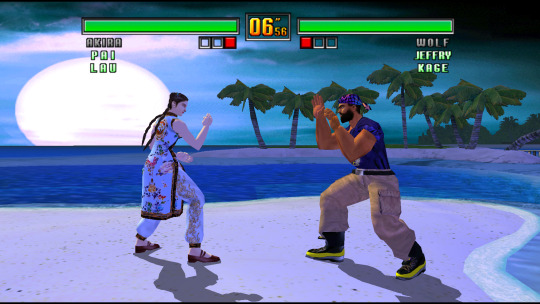
Custom background scaling
We can apply our own custom scaling using some post-production. First, change Supermodel's glClearColor to a chroma key-friendly hue (e.g. magenta) and edit CRender2D::PreRenderFrame or prevent calls to CRender2D::RenderFrameTop. This combination will give us background-free footage, onto which we can then apply the relevant texture with our the scaling of choice in post.
I obtained VF3's background textures by dumping them from the Dreamcast version.
Here's a proof of concept - note the magenta fringes around the palm trees due to imperfect filtering:
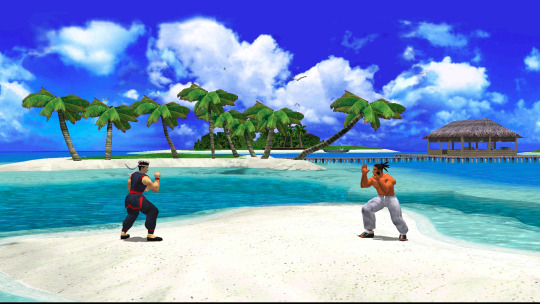
Bonus: Debug mode
Hold Punch + Kick + Guard + Escape, and then press Start, to begin the game in debug mode. In debug mode, our inputs are printed to the screen. The advanced debug controls of VF2 either don't exist in VF3, or require a currently unknown button combination to access.
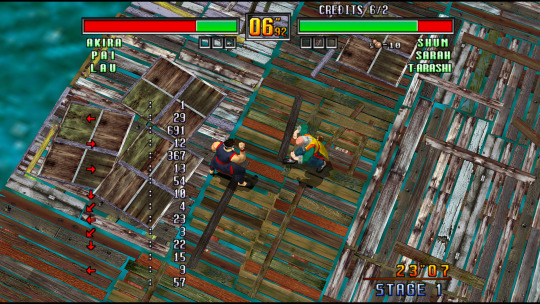
We can also enter debug mode in 2-player.
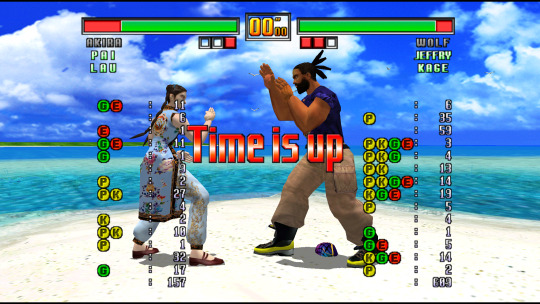
Appendix 1a: Failed approaches to disabling music
The arcade machine's service menu offers a "Sound Balance" option, but it doesn't disable music as I'd hoped. Perhaps it merely adjusts certain mixing parameters.
Moving on, I found that Supermodel has a launch option for setting music volume:
Supermodel.exe ROMs\vf3tb.zip -music-volume=0 -input-system=xinput -wide-bg
However this doesn't effect on VF3, nor does pressing Supermodel's keys (F9/F10) to adjust music volume, because these options don't apply to the way VF3 implements music.
Appendix 1b: Creating custom SFX mixes
The service menu also includes a Sound Test. This allows us to play, and therefore record, sounds in isolation. We could then mix them via the sound editor of our choice to create a replica of what's heard in-game.
Appendix 2: Failed approaches to hiding player-characters
I first told Supermodel to skip mesh draws at random, which revealed that a character is in fact made of many meshes. This suggests that skipping character rendering using this method would be difficult, if not impossible.

Not quite ready to give up, I tried passing ENABLE_DEBUGGER=1 flag to the Make command in hopes of getting more info (i.e. the mesh indices of the two characters). Looking in code, I found a SUPERMODEL_DEBUGGER definition that's likely supposed to reflect it. But, compilation failed with ENABLE_DEBUGGER=1 for various reasons - maybe I was doing something wrong, or perhaps the feature is no longer maintained.
Appendix 3: Hiding the Dreamcast HUD
On Dreamcast, we can supposedly do this by holding X and then press A while the game is paused. But I found this only partially hid the HUD - if we wanted to capture Dreamcast, it would be better to load a completely transparent version of the HUD using Dreamcast emulators' custom texture loading features.
Dreamcast also has the HUD hidden until just before Training Mode gameplay starts - offering an opportunity to grab a HUD-less screenshot. However, as mentioned above, Dreamcast's visuals differ enough from Arcade that we can't overlay these captured stills onto our Arcade footage.

For a somewhat absurd approach, we can use Dreamcast emulators to dump VF3's background textures and then use those as an overlay onto our Arcade footage. However this will only work for stages without any geometry intersecting the HUD. And of course, these dumped textures are unshaded and may not match the way they are drawn in Arcade. Note the visible seam in this proof-of-concept:


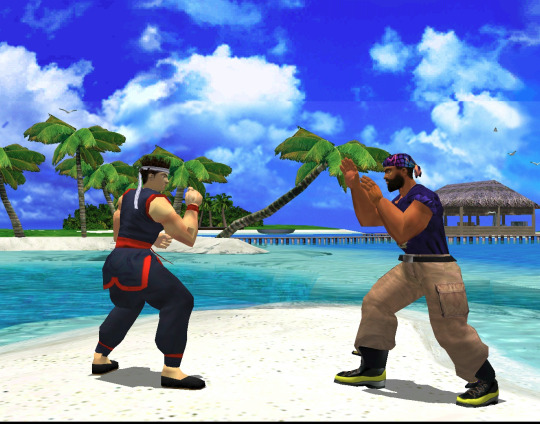
2 notes
·
View notes
Text
Whoever sent the ask about Journey, Tumblr ate it and had a stroke, here’s your answer!
THIS POST ORIGINALLY HAD PICTURES AND A VIDEO BUT TUMBLR DECIDED NOT TO ALLOW ANY OF THAT TO GO THROUGH. THIS IS A LONG-TERM ISSUE THAT HAS BEEN REPORTED BY SOME USERS AS FAR AS TWO WEEKS BACK.
Oh boy, I hope you don't mind the nerdy rant that's coming because ngl, I have a LOT to say about this game that hasn't even properly released yet.
AFK 2: Journey is an upcoming game collab between Lilith Games and Farlight Games. You may recognize this combination of developers from Dislyte, but don't worry, this is nothing like Dislyte. Well, at least not in the bad aspects of it. You can view the official trailer for the closed beta right here and there are already plenty of people who made videos about it on YT regarding the gameplay and general feel of the game. In short, it's a more or less open-world game where you play as a prophesized savior of Esperia against one particular threat. I'll go more into detail about what is and isn't in the game under the cut so I don't take up too much space on the timeline and I'll also be adding some pictures and maybe even videos of the game itself.
As I was a part of the closed beta testing, I was able to already see what the game had to offer, and here's my crude review. It won't go over everything so if you have any additional questions, feel free to ask.
So to start with, what separates this game from the already existing AFK game, AFK Arena?
Well, for starters, it features 3D graphics. Now, usually, I'm not too big a fan of 3D graphics. It was my main issue with Dislyte (until I looked at the gacha properly at least), and I'm not a fan of Genshin's style for this very reason. 3D graphics make games difficult to run on devices with overall lower performance and everything becomes that much bigger in the storage as well. Not to mention, usually it doesn't even look good and 2D would've provided a lot more emotion and creative freedom. Genshin constantly struggles with supposedly emotional moments falling flat because of both pacing and the limited range of emotions in their 3D models. Dislyte doesn't animate most stories and thus avoids this pitfall... without actually fixing the problem either. On the other hand, I think Journey did a good job portraying emotions even on the NPC faces despite the 3D model limitations. If anything, they were a bit too much at times. The overall body language definitely added to this though so it's not like everything hung only on the facial expressions. They weren't afraid to utilize their whole models to get the feeling across and it certainly paid off. And sure, the expressions are still sometimes a mess and my poor screenshotting skills definitely don't help my case, but you'll see what I mean with the videos. For now, have this.
(very awkward screenshot of a sad bunny mom was here)
The model is a little awkward because of the screenshot but Adeline really sold her distress. She was constantly rubbing at her eyes wiping her tears away, blinking them away, and shaking. She's afraid about her lost child and she behaves like someone in such a situation. She doesn't stand stiff and stare blankly off into the distance.
Another key difference is the aforementioned open world. Now again, it is not quite as open as in Genshin, you cannot climb or swim, and a lot of locations require you to follow specific paths to get to, but you can still frolic in the fields of grain and go off course to grab a random treasure chest or fight a random enemy. You also get rewards for filling out the map. You can choose up to four characters you have drawn in gacha to follow you around and they have no relation to your party whatsoever so you can just put your favorites there without having to worry about combat. The world is split into several larger areas with a bunch of smaller areas within each one. You can progress to the next areas regardless of where you are in the main story which is nice. There's no Inazuma situation where you can't go somewhere until you get there in the story. Every bigger and smaller area is locked behind a small boss fight and there are also teleports on the map. Much appreciated is also the auto-pilot function where you can simply choose a goal and your character will automatically find the shortest route to get there if it is possible, and then walk on their own.
Last but not least, I need to talk about the main character. AFK Arena is wonderful thanks to it not having a main character to dictate the course of its story, even though it kind of seemed like that's where it was going at the start. Journey, on the other hand, decided to commit to the idea of having a playable main character. I wasn't a fan of it when I first heard about it but it kind of blew me away with how seamless they made it and how neatly it fits in with the rest of the game. I will get more into the MC a little bit later.
That were just the key differences between AFK Arena and AFK 2: Journey. So let's talk more about Journey itself.
The story of the prologue, and thus kind of the overarching story, is a little cliché at the start. No star-traveling twins fighting an evil god and getting separated, no world of godly powers bestowed upon mortals. There is a prophesized main character, us, who was foretold to save Esperia from the spreading corruption of dark miasma. That's right, no Hypogean threat and war between good and evil, well at least not in the traditional sense of the word. Also, we have amnesia. But don't worry, there's a reason for it. At the start of the game, we get found by a duo of traveling mercenaries, Ella and Valen. Ella is a mage who studied at the Astral Academy, while Valen is a sword-user, though he can't really be called a knight, and they were hired by someone to find this someone's master. At the start of the game, after they find us, we are completely covered up, you can't see anything at all about the MC.
(a screenshot of a covered up MC was here, they are wearing full-body robes that go over their head and a full face mask that hides their whole face, on their chest is a white gem)
This becomes important later because after meeting with the client who sent them to find us, we are taken to our main base – a building on the back of a massive terrestrial creature that has all the possible accommodations including the Noble Tavern (with best girl Dolly) and a changing room. The MC, once you get past the prologue, is CUSTOMIZABLE. You can pick between the male and female body, there's a variety of skin tones, both natural and not, and you gain avatar items as you progress the story or you can buy them from the shop. You can get fox ears, a monocle, an eye mask, full-body outfits, and more. This honestly excited me so much and it immediately elevated this game in my head so much more. Furthermore, while the MC doesn't fight on your team, they stand in the back and provide various valuable buffs from healing to attack power-ups to even damaging enemies. In a way, the MC is functionally similar to the new Beasts feature in AFK Arena.
The one drawback I would call out is that there's not really much of anything just yet but this was just the closed beta after all. They'll probably add a lot of new stuff before the actual release. You can also choose a faction for your avatar frame but the only ones in the game so far were Lightbearers and Maulers, and the Lightbearer one was the default frame while the actual Lightbearer-looking frame was labeled as Maulers, so nothing is perfect, but there is a very solid base that we could see great expansions upon.
Aside from the MC, you build a team of up to five heroes much like you would in AFK Arena. You also get tutorial heroes for free. These heroes are Ella, Valen, Chippy, and Hammie. Speaking of whom, Chippy and his cousin Hammie are the two who originally hired Ella and Valen and though I would personally consider them related to the Wilders or Maulers, they were apparently accepted as Lightbearers. Maybe the centuries-old race war is finally getting better? Chippy looks like a chubby little hamster knight and works as a tank, and Hammie is similar to a white weasel and has minor magical powers and healing abilities. They come with a whole family of similar creatures who all work for us and do lots of little background things like scouting out maps for treasure and enemies. What's most important though is that they are absolutely ADORABLE!
(several pictures of cute little fuzzy babies were posted here, you can still find Chippy as the game's official profile picture on FB, and Hammie appeared on the closed beta announcement picture)
Aside from the starting four, you can recruit characters through a gacha system in the tavern, just like in the old AFK Arena. The gacha now has an animation that, while far from great, I just can't stop watching. And it is pretty much only for the Dolly animation and especially the way her skirt twirls. 3D animated skirts usually tend to be awfully stiff or feel heavy and suffocating, but as someone who wore them quite a lot not that long ago, I appreciated how realistic and light Dolly's skirt seemed in it. This is a weird detail to get hung up on, I know, but I always focus on weird things, we all know that by now.
(a video of the gacha pull was here, it opens in a cozy-looking shared space with a bar, several tables, a changing room, and even a small store, Dolly is cleaning tankards when she notices the player came to gacha and sets her work down to motion towards larger animations playing out behind her where we can see some of the characters we can pull, after clicking on the 10-pull option, she runs out to the balcony and tosses out a handful of envelopes that fly into the air, day turns into night and a single envelope returns, lighting up beacons indicating the rarities of heroes in the pull)
And yes, I keep mentioning Dolly. However, Dolly is not the only familiar face we'll meet in Journey. A whole set of heroes from AFK Arena shows up in Journey as well. From the Lightbearers, we have Lucius, Rowan, and Mirael, from the Maulers, there's Brutus, the Wilders brought Eironn and Lyca, and the only Graveborn from the original game who made the cut, for now, is Thoran. Aside from them, the game also has a plethora of new original heroes. And these heroes certainly look every bit as unique and diverse as you would expect from an AFK game! During the beta, the game didn't have any backstories just yet, but it had a dedicated space for them so we can expect them to show up soon. Let me quickly walk you through the new heroes!
(two pictures from the promo materials were there; the first one depicted Ella, a young and fairly androgynous woman with chin-length white hair and blue eyes, she is wearing a blue barret, a white and gold vest with a closed top and a turtleneck, blue cape falls from it on both front and back and the front part is divided into two halves, leaving an opening to see her vest through, she also has dark blue booty shorts and long cream-colored stockings on, she wields a golden staff with a blue gem on top; the second picture depicted Valen, he is a leisurely looking young man with a mess of brown hair falling down to his shoulders and wears a white shirt with a dark blue tunic and a fur-lined brown cloak together cream-colored pants and high brown boots, he is equipped with a sword as well as leather arm braces, by his waist hangs the sheath and another sheathed sword)
First, we have Ella and Valen (and sorry I don't have my own screenshots for them, I have their animations). Both of them are Lightbearers and I also introduced them a little bit, but since they play a big part in the main story, I can talk more about their personalities. Ella is smart and relies on her wits but is prone to anger at times and has a strong sense of justice. On the other hand, Valen is laid-back and more careful about how he comes across to others but he has a good head on his shoulders and remembers to consider options outside of what's right in front of our faces. They're a refreshing duo and it's easily understandable why they've stuck together as mercenaries.
Sadly, Chippy and Hammie don't really show up much after the prologue so there's not much more to them other than being loyal and very adorable. Chippy has great faith in us as the prophesized hero while Hammie has a more leveled approach and keeps things on the cooler side.
(a picture here depicted Merrin, she is a young blonde woman, her hair is tied in twin braids but several strands escaped and stick out wildly, she's wearing a white short-sleeved shirt and brown pants rolled up to her knees and on her head sits a white and blue Robin Hood-style hat, she wields a bow and by her hip hands a quiver of arrows and a fox tail, she also has a dagger strapped to her other hip)
The Lightbearer lineup is finished by Merrin. She's born of noble blood but after her mother got murdered, she ran away from home seeking vengeance. This is actually a part of the main story so I don't want to spoil too much but she is very energetic, dedicated, and doesn't mind changing plans on the run if she can attain her goal. She's also not stubborn and can admit when she made a mistake, but she won't put up with nonsense. She's a genuinely refreshing character in an already very good story quest.
(a picture here depicted Hewyn, she is a small girl with pointy ears, her golden hair is tied in two braids and rolled up on the sides of her head, there is a tear-shaped mark on her forehead, she has green eyes and a somber or perhaps distrusting look, she is wearing an ankle-length dress of white and green with a few golden touches and holds a leaf bigger than she is as an umbrella or maybe to provide shade from the sun)
Moving on to the Wilders, we have Hewyn. Unfortunately, if she does appear in the main story, I didn't get to her during the beta so I can't really talk much about her, but she is a dedicated healer and her healing is absolutely busted. I'm sure this will get rebalanced soon but during the beta, she was easily healing 50k HP with her ult while my main AoE DPS dealt a little over 13k damage to the enemies. In her animations, she appears very shy and almost fearful.
(a picture here depicted Seth, a powerfully-built anthropomorphized black panther, he has golden tattoos or perhaps paint on his chest like the rays of the sun coming from below where his neck protection spreads over his shoulders, the neck protection gear is connected to a sleeve over his right arm, both of his arms sport leather bracers, he also wears tight pants of light leather and there are several protective bindings on his legs, his claws are painted gold, by his waist are several signal horns fastened to a wide belt)
That's all the Wilders so moving on to the Maulers. This is Seth and he's a black panther assassin. And that's all I know about him since he doesn't have a backstory and his animations seem generally guarded so I can't read much into them.
(a picture here depicted Bo, he is a massive rhino with a huge battering ram in his arms, he is wearing a fur-lined red attire and sports red body paint around his neck, he is also equipped with heavy-looking arm bracers and a protective piece on his head going from between his eyes to around his horn for which it has a hole, the armor seems to be made of black scales and held together with golden seams, he also has a golden nose ring)
Bo has to be one of my favorite designs simply for how unconventional he is. He's just. so. large. He's the tankiest tank who ever tanked. But in his animations, he also appears very aloof and sleepy, like he used a lot of energy charging and pushing back the enemy, and now he just needs a nap.
(picture here depicted two meerkat-looking Maulers, one significantly larger than the other, obviously the adult of the two if they truly are the same species, the smaller meerkat isn't wearing any clothes but is holding a blue bottle while the larger meerkat creature is wearing a red vest and red and brown drop-crotch pants, as well as red wrist bracers and a colorful necklace, they have dreadlocks on the back of their head and a green stalk between their teeth, one of their hands is extended forward and would be holding a censer if my screenshots weren't always taken in the worst possible moment)
Daka and Waka are a support duo of Maulers whose entire kit revolves around spreading smoke from their censer with different kinds of incense granting different buffs for their allies, with healing added to the mix at their ult. I couldn't even tell you which is which but know that the bigger one of the duo seems to be a parental or guardian figure to the smaller one – and is very anxious about anything possibly happening to their protegé.
(the picture here depicted a ginger hyena with a surprisingly large and fluffy-looking tail as well as very defined and round buttocks, he isn't wearing anything but a loincloth, a shoulder pad on his right shoulder, and a few leather straps that hold his quiver of blowdarts in place on his back, he has a blowgun in one hand and holds the index finger and thumb of the other hand up as if in a greeting, by his waist hangs the skull of a small cow and an inconspicuous flask, he has a leisure relaxed smile on his face, his eyes half-lidded)
The last Mauler of the bunch is Eddie. Okay, I lied, Eddie is probably my favorite design. He attacks with a blowgun and has a very relaxed air around him. For some reason, they gave him the seductive eyebrow wiggle in one of his animations. He's pretty decent at close combat too but definitely prefers to stay at a range.
(depicted here was Lelana, a graveborn young-looking woman with a very sleepy look to her, she has dark circles around her eyes like she hasn't slept in a very long time, her hair is very long and goes from dark gray on top to very light pale green at the ends, she is wearing a long layered dress of dark blue and dirty white with motifs of snowflakes towards the bottom, the white parts of her dress resemble melting snow, her long sleeves are poofy and white and she's wearing white gloves, over her shoulders is a dark blue overcoat and her neck is protected by a ruff, she is holding a tall and thin candelabra with three candles)
Lelana is absolutely gorgeous. That's it, that's my review. No, I'm kidding obviously. She's a mage who summons snowballs and snow-themed attacks, and I think her outfit is very lovely. It has the weight of a heavy blanket to it and it works really great. She doesn't move much but what few moves she does have in her animations are all fluid and elegant, albeit tempered.
(the last picture in this post was Igor, a graveborn whose face is completely hidden behind a knight-like helmet with only his long light green hair escaping it, a sword is sticking out of his upper back causing him to be hunched forward, a large iron with three heavy nails is rammed across his shoulder blades, and he has a heavy spiked shackle around each wrist, he isn't wearing a shirt and his pants, though they have holes in them, are a similar color to his skin but he is also wearing a loincloth over his pants, he dual-wields large blades and is crouching on a gravestone)
And last but certainly not least is Igor. He is somewhat similar to Grezhul with his kit of summoning gravestones but unlike Grezhul, he can teleport between them and activate them, giving debuffs and, I believe, damage over time to all enemies within a certain range. As for his animations, most are surprisingly aloof and seem to kind of hint at him perhaps feeling lonely as he currently is. Though only a full backstory will be able to tell us everything we need to know.
I will not get too much into the story and gameplay in this answer as this is already long enough but I want to mention one more thing regarding the battles.
Aside from the battles having a hexagon grid system and thus a lot more combinations for positioning the party. Furthermore, there are various battle modes that allow you to experiment with your teams and units to figure out who works best where as well as devices you can manually use to turn the tide of battle. For example, there are defense battles where you need to defeat waves of enemies before they can damage a cart of supplies. There are solo battles where you can only use a singular hero to defeat several opponents. There are also tactical showdown battles where you can pick a limited number of units from a preset group and defeat tough enemies. The devices include a water gun that slows enemies down, walls and barricades that need to be broken down or circumvented, a flamethrower that deals damage and lingering burns, and more. The combination of all of these makes the battles really engaging and enjoyable, though, of course, you can still steamroll almost everything with high enough levels. There's also PvP, boss battles, and Labyrinth (although that one needs some severe adjustments).
Well, I'll get off my rant now, I'm sure I've wasted enough of your time. If you wanna see anyone's animations that I talked about or are ready to listen to me rant about the AFK Arena characters and their designs in the 3D art style, or anything else, hit me up anytime! My brain is overflowing with this game rn so I will be more than happy to answer anything!
#afk arena#afk 2 journey#afk journey#long post#sorry for ranting#also this took way too much time#tumblr had not one but at least twenty strokes#at the end of which it deleted the original ask#thanks a lot tumblr
21 notes
·
View notes
Text
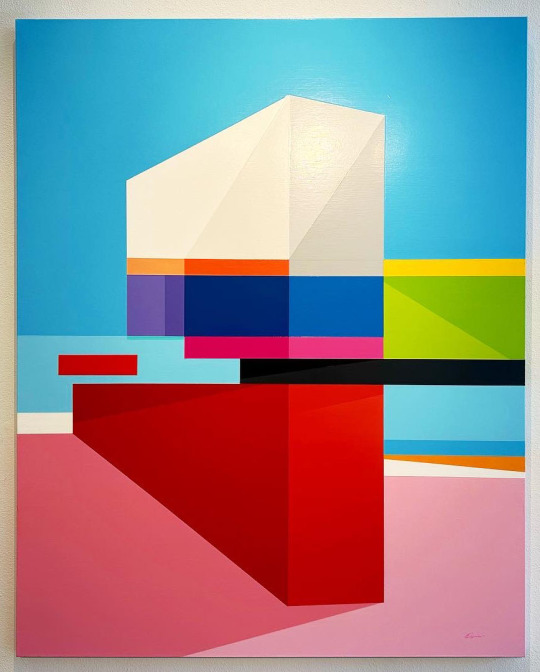
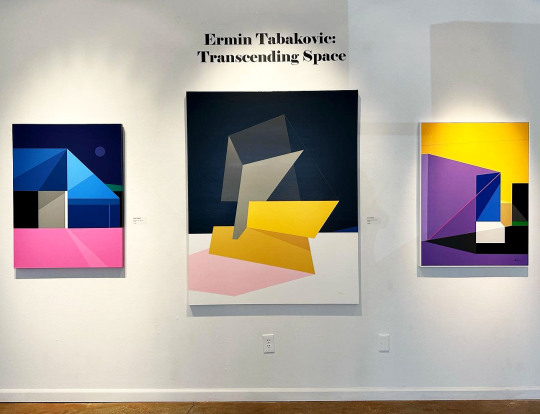



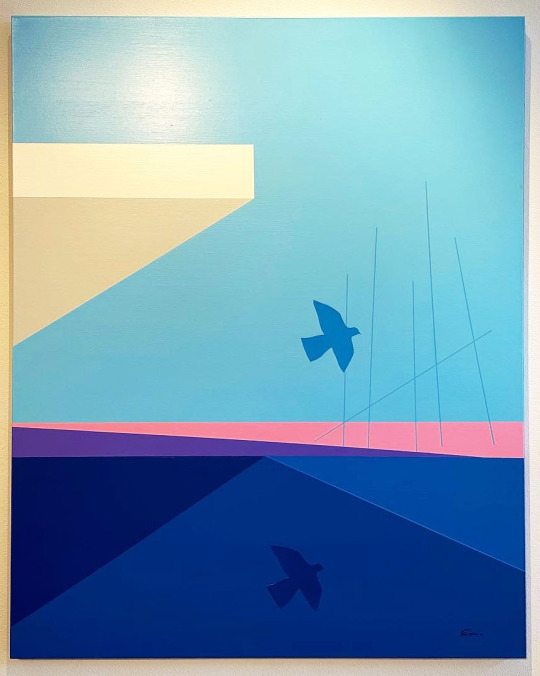
Ermin Tabakovic has created an intriguing world with his geometric paintings for Transcending Space, on view at Morean Arts Center in St. Pete.
From the gallery’s website-
Ermin Tabakovic was born in 1980 in former Yugoslavia (now Bosnia). In 1993 he and his family moved to Berlin, Germany where they lived between 1993-1998. As a teenager in Berlin, Ermin was involved in the city’s vibrant graffiti art scene and completed numerous murals. In 1998 he and his family emigrated to the United States, settling in the Tampa Bay area. Upon arrival in the US, Ermin took on painting and studied at St. Petersburg College where he focused on art and architecture. He went on to study art at the University of Central Florida in Orlando where he completed his BFA in Art Studio with Minors in Graphic Design and Art History.
Ermin actively exhibited his work between 2000-2008, taking part in many shows throughout Florida. He stopped painting in 2008 due to health issues and picked it up again in 2020 with a new vigor and a new vision. His new works are mature, colorful and bold representations of his core vision and aesthetic steeped in geometric form and a structural sensibility. Currently Ermin resides in Tampa with his wife Lisa and their beloved cat Maximus.
“Modern geometric painting has had a very big influence on my work, especially the Constructivist artists such as Malevich and El Lissitzky and the various other modern Art movements of the 20th century such as Cubism, Neoplasticism, Minimalism, and Surrealism. In my current work I tend to fuse all these different influences and combine them with my own personal aesthetic to create a new visual language that transcends the past and points to something new and different. We live in a digital age, so there is that digital touch to my compositions as well by using the hard-edge approach.
“I want the works to be visually striking, thus my use of vibrant colors, contrast, pure and robust geometric forms, clean lines, etc. I also like to add a surreal touch to my works to give them a sense of mystery and visual drama. Furthermore, I seek to create visual paradoxes by intertwining 2D and 3D space to add tension and ambiguity. My aim is to challenge the viewer’s perception of space and test the boundaries of what is possible by juxtaposing the seemingly impossible.”
This exhibition closes 10/26/23.
#Ermin Tabakovic#Morean Arts Center#Art#Art Shows#Florida Art Shows#Florida Artist#Florida Artists#Geometric Painting#Painting#St. Pete Art#St. Pete Art Gallery#St. Pete Art Shows
2 notes
·
View notes
Text
Dordogne
Developed by UN JE NE SAIS QUOI & UMANIMATION
Published by Focus Entertainment
Release Date 2023
Tested on Xbox Series X
MSRP 14,99 USD
youtube
Are you looking for laid-back-and-chill vibes? Dordogne is your pick. With its unique graphic style (a hybrid of watercolour and pastel painting) enhanced with a smooth narrative and storytelling, this title deserves your attention as a great indie game. On surface level I thought the game was merely focusing on story and the player did not have much engagement, but I was wrong because the game teaches you so many mechanics that you are constantly interacting with the world you find yourself in. Depending on scene, the game employs both 2D and 3D environments and movement, for example if it’s only a cutscene and there is not much engagement from your end, it is 2D, when your movement and interaction is prioritized it is 3D.
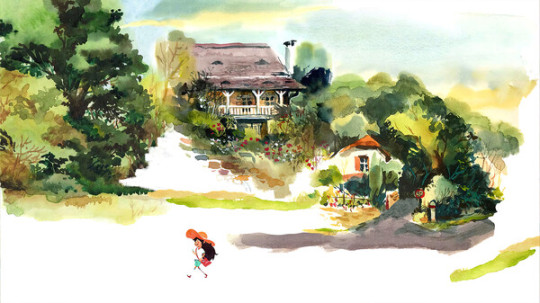
Not to give any spoilers: you are playing as Mimi, an adult woman who lost a family member and her job recently and returns to Dordogne, a summer house, after all these years to find solace in memories and recollections of the past, diving into nostalgia, coping with her current loss thanks to joyful and golden days. From time to time, you experience flashbacks as young Mimi and the game successfully presents you a dual-world to you. Throughout the game, the narration progresses through flashbacks, belongings, and most importantly letters you come across in the house, please do not just skip the letters because they’re most heart-felt letters you can read in a game. One last thing: the present time is 2002, and flashbacks do take place around 70s. So there’s a wide 30-year gap between adult Mimi and young Mimi.
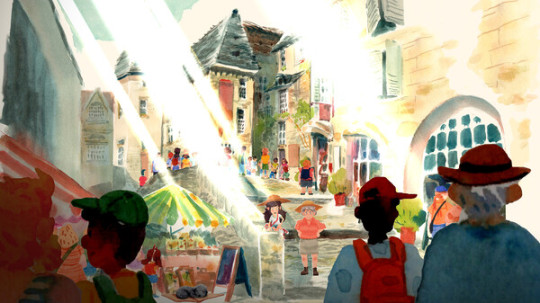
Dordogne makes use of point-and-click game mechanics as well, and I must confess, the interactions with items is top-notch, it is so detailed, meticulous and you can be thorough with them. When you grab an item, the game enables you to tinker with it. For example when you are to open a door, you move your cursor over the doorknob, hold it there, and move your thumbstick as instructed, as if you are actually opening a door. It is not just “click A to open the door”, you are putting yourself in role of Mimi and opening the door. It works excellently and obviously the developers spent enough time to make sure when you’re engaging with an item the player does not feel “but this is not player-friendly at all”.
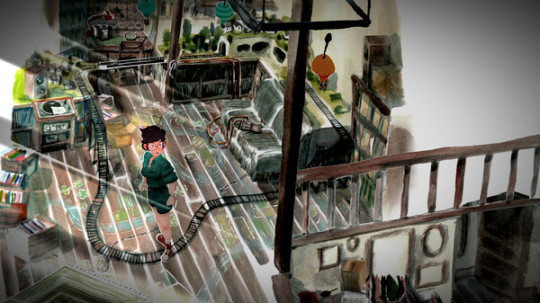
For instance, in the video below you can find that, you are unpacking you luggage with each item there’s interaction and dialogue with the clothes while you are organizing them in a drawer:
youtube
You bump into some collectibles as well, which are stickers for your journal. Also, there’re player-focused dialogues choices too, what you prefer to say has effect on your vocabulary that you can use to write poems, you can see at 00:27 the words I chose. I did pick “I hate here” when I was talking to my grandma, and I can use it to write a specific poem line about it:
youtube
Player-centred dialogue mechanic is put into the game so well that I am really impressed, such as the moment where you’re having a breakfast with your grandma and you reflect how you feel with the food you are going to eat, such as “sweet”, “bitter” etc. Your decision-based engagement is combined with the items in front of you so smoothly.
Dordogne is a must-experience for all indie and narrative-heavy lovers, it is touching, warm, down-to-earth, and sincere.
4 notes
·
View notes
Text
The Wandering Village city builder to release soon

The Wandering Village city building simulation game will release soon on Linux, Mac, and Windows PC. Thanks to the work of developer Stray Fawn Studio. Due to making its way onto Steam Early Access.
Stray Fawn Studio has announced that The Wandering Village is due to release on September 14th. This also includes support for Linux, Mac, and Windows PC. Inspired by Hayao Miyazaki’s Nausicaä of the Valley of the Wind. The Wandering Village is a unique city builder taking place atop the back of a giant roaming creature known as Onbu.
Combining city building and resource management. Along with rogue-like and survival game elements. This is where players will need to forge a close relationship with the giant creature. Doing so if they’re to endure the dangerous, post-apocalyptic world. From farming crops and gathering rare resources to scouting the setting. As well as expanding their settlement. Players must also maintain the creature’s health. All while balancing the needs of their villagers if they’re both to survive.
The Wandering Village - Launch Trailer
youtube
Faced with crazy weather, bloodsucking parasites, poisonous spores, and limited resources. All while settling on the back of a living, breathing beast won’t always be easy. Reacting to unique chances and setting threats. Since you will adapt your village and its needs. Traveling through a variety of dangerous biomes, is key to the player’s journey.
In The Wandering Village, forging a relationship between the villagers and Onbu might be a test at times. Since their interests often don’t align. As a living creature, its unique body poses its own tests for your village design. There’s every chance a spike may have grown where villagers intended to place their kitchen. Due to a failed harvest that may cause desperation. Tempting villagers to draw blood from the creature for food.
Successfully backed on Kickstarter and after three years of development. The Wandering Village has also climbed into the top 30 most Wishlisted games on Steam.
Key Features:
Build a unique village on the back of a giant creature known as Onbu
Farm various crops to feed your villagers
Send out foraging missions to gather rare resources
Survive a variety of different biomes and events
Build a relationship with a giant beast and influence its actions
Research and construct a variety of different buildings
Ecology/Biology inspired gameplay
Unique art style with a blend of 3D and hand-drawn, hand-animated 2D graphics
The Wandering Village city building simulation game is coming to Steam Early Access on September 14th. Priced at $24.99 USD / £19.99 / 23,99€. Along with support for Linux, Mac, and Windows PC.
#the wandering village#city building#simulation#linux#gaming news#stray fawn studio#ubuntu#mac#windows#pc
6 notes
·
View notes
Text
Week 7 Studio Tutorial – Physical Model Making (foam)
Part 1 and 2: Constructing profile templates and cutting foam blanks
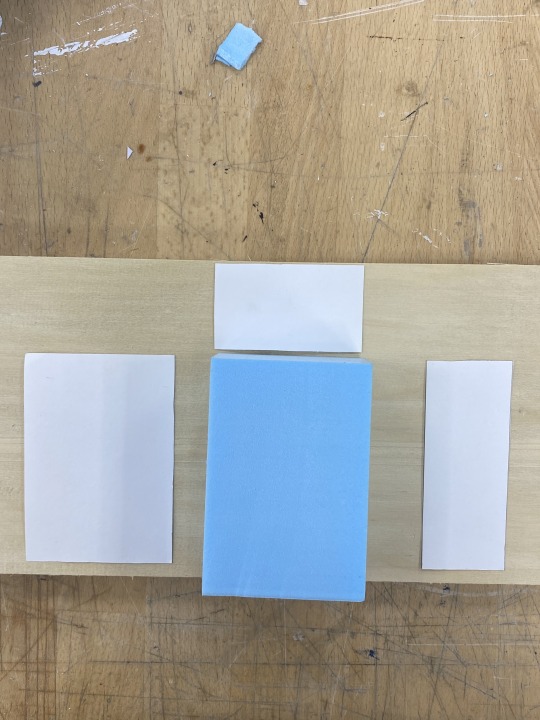

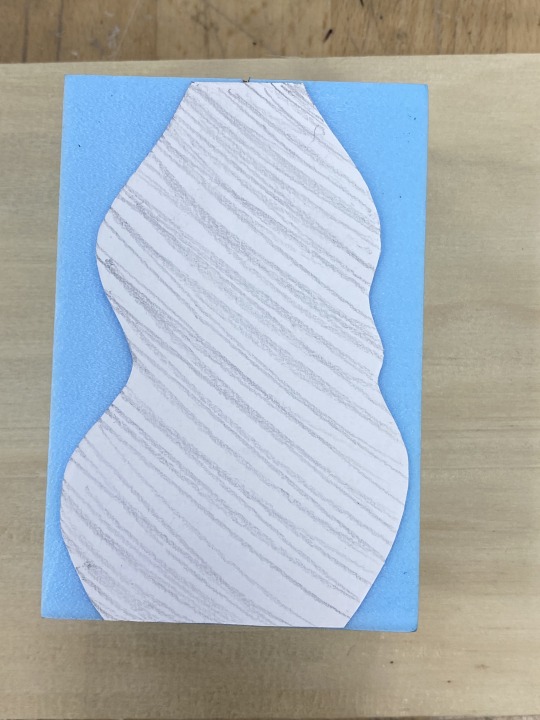


Before this task, I had been creating 3D blue foam forms freehand without any templates. At first glance, I thought that the method of using templates was time-consuming and potentially somewhat pointless. However, after giving it a go, I found that it allowed me to get to the general form I was after much quicker and without the extra thought and confusion of translating a 2D sketch to 3D model that I sometimes found with going straight into a block of foam without planning.
Part 3 and 4: Roughing-in an extruded front view and refining the bottle form


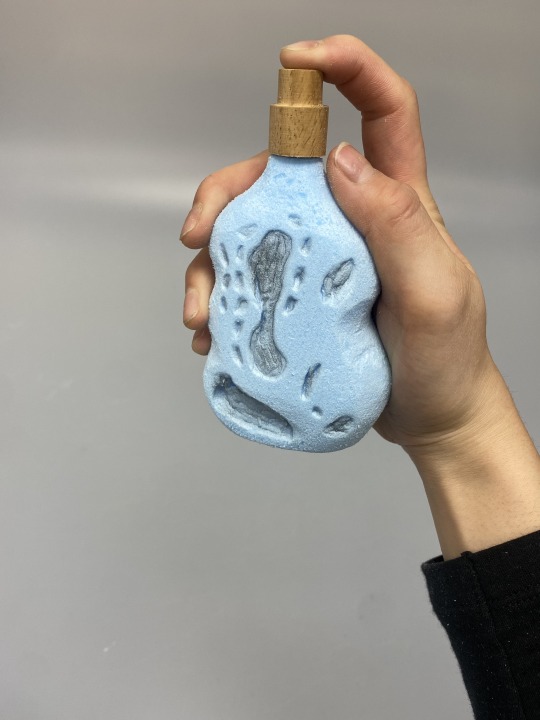
Whilst getting to the general form was quicker and more effective, this method provided less opportunity for improvisation and the happy mistakes that happen sometimes without a template. Therefore, I think it's a method I'll employ when trying to make rough prototypes from 2D thumbnail sketches to 3D form to get an idea of how they'd feel in the hand, or, a method for a final, very, accurate model. However, I think freehand forming with blue foam is something I'll go back to because of the looseness and opportunity for creating new forms through a different, tangible process of experimentation that may lead to new ideas and designs. I think that a combination of both methods can lead to the most successful final outcomes, as going back and forth between processes of sketching and model-making provides variety and therefore, opportunity for more innovative designs.
Other prototypes
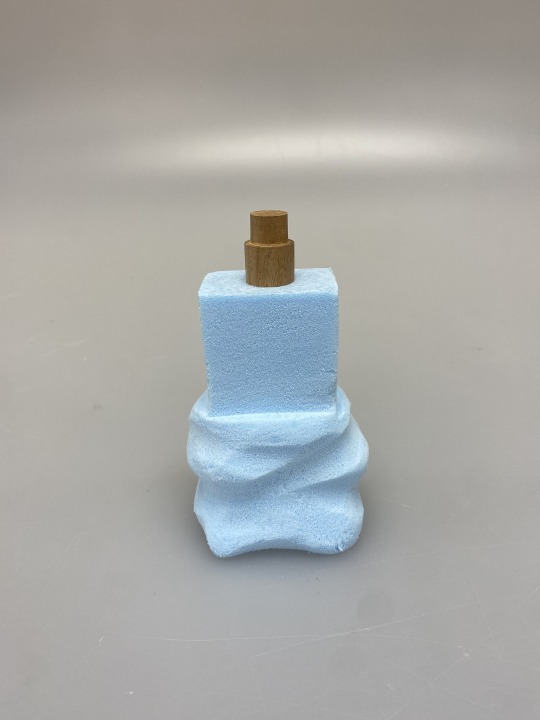

These were some forms I created freehand. With the first model, I think that forming it freehand allowed for the interesting variety and asymmetry and flow of the bottom half, which, if I had used templates, might be more regular and prism-like. However, I think that a simple template with two different sized rectangles for the top and bottom half may have been helpful to create a more balanced ratio.
With the second model, I definitely think using a template would've saved me some brain power, since it is a rather controlled yet organic form, which was a bit of a process to get to without a template.
Overall, I think that this lesson was helpful in introducing me to a method of modelling I hadn't come across or thought of previously. It's definitely something I'll go to when I think it'll be helpful and more efficient. Rather than following the process step by step, I think I might use templates simply to create general forms, ratios etc. rather than creating really accurate or complex templates, so that I have some room for creative improvisation through sculpting.
If I were to redo the exercise, I would ideally create templates for multiple models to really test out if it'd be a helpful method for me rather than being skeptical. This could lead to developing my own process of model-making with blue foam.
5 notes
·
View notes
Text
Introduction to RK3588
What is RK3588?
RK3588 is a universal SoC with ARM architecture, which integrates quad-core Cortex-A76 (large core) and quad-core Cortex-A55(small core). Equipped with G610 MP4 GPU, which can run complex graphics processing smoothly. Embedded 3D GPU makes RK3588 fully compatible with OpenGLES 1.1, 2.0 and 3.2, OpenCL up to 2.2 and Vulkan1.2. A special 2D hardware engine with MMU will maximize display performance and provide smooth operation. And a 6 TOPs NPU empowers various AI scenarios, providing possibilities for local offline AI computing in complex scenarios, complex video stream analysis, and other applications. Built-in a variety of powerful embedded hardware engines, support 8K@60fps H.265 and VP9 decoders, 8K@30fps H.264 decoders and 4K@60fps AV1 decoders; support 8K@30fps H.264 and H.265 encoder, high-quality JPEG encoder/decoder, dedicated image pre-processor and post-processor.
RK3588 also introduces a new generation of fully hardware-based ISP (Image Signal Processor) with a maximum of 48 million pixels, implementing many algorithm accelerators, such as HDR, 3A, LSC, 3DNR, 2DNR, sharpening, dehaze, fisheye correction, gamma Correction, etc., have a wide range of applications in graphics post-processing. RK3588 integrates Rockchip's new generation NPU, which can support INT4/INT8/INT16/FP16 hybrid computing. Its strong compatibility can easily convert network models based on a series of frameworks such as TensorFlow / MXNet / PyTorch / Caffe. RK3588 has a high-performance 4-channel external memory interface (LPDDR4/LPDDR4X/LPDDR5), capable of supporting demanding memory bandwidth.
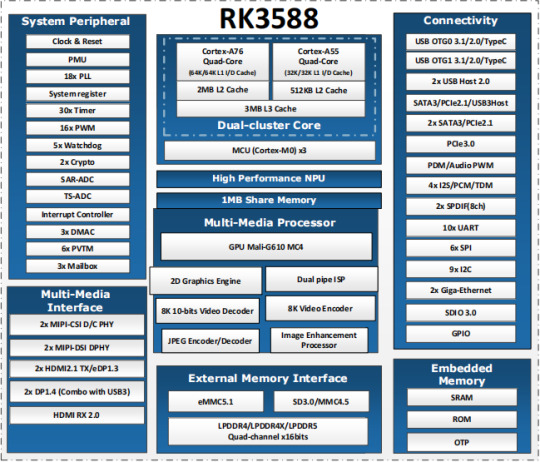
RK3588 Block Diagram
Advantages of RK3588?
Computing: RK3588 integrates quad-core Cortex-A76 and quad-core Cortex-A55, G610 MP4 graphics processor, and a separate NEON coprocessor. Integrating the third-generation NPU self-developed by Rockchip, computing power 6TOPS, which can meet the computing power requirements of most artificial intelligence models.
Vision: support multi-camera input, ISP3.0, high-quality audio;
Display: support multi-screen display, 8K high-quality, 3D display, etc.;
Video processing: support 8k video and multiple 4k codecs;
Communication: support multiple high-speed interfaces such as PCIe2.0 and PCIe3.0, USB3.0, and Gigabit Ethernet;
Operating system: Android 12 is supported. Linux and Ubuntu will be developed in succession;

FET3588-C SoM based on Rockchip RK3588
Forlinx FET3588-C SoM inherits all advantages of RK3588. The following introduces it from structure and hardware design.
1. Structure:
The SoM size is 50mm x 68mm, smaller than most RK3588 SoMs on market;
100pin ultra-thin connector is used to connect SoM and carrier board. The combined height of connectors is 1.5mm, which greatly reduces the thickness of SoM; four mounting holes with a diameter of 2.2mm are reserved at the four corners of SoM. The product is used in a vibration environment can install fixing screws to improve the reliability of product connections.
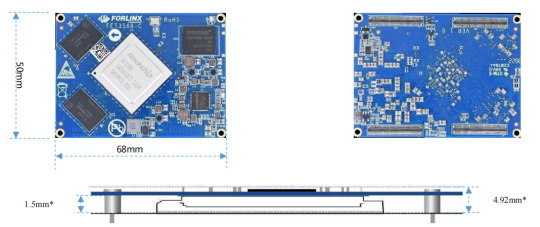
2. Hardware Design:
FET3568-C SoM uses 12V power supply. A higher power supply voltage can increase the upper limit of power supply and reduce line loss. Ensure that the Forlinx’s SoM can run stably for a long time at full load. The power supply adopts RK single PMIC solution, which supports dynamic frequency modulation.
FET3568-C SoM uses 4 pieces of 100pin connectors, with a total of 400 pins; all the functions that can be extracted from processor are all extracted, and ground loop pins of high-speed signal are sufficient, and power supply and loop pins are sufficient to ensure signal integrity and power integrity.
The default memory configuration of FET3568-C SoM supports 4GB/8GB (up to 32GB) LPDDR4/LPDDR4X-4266; default storage configuration supports 32GB/64GB (larger storage is optional) eMMC;
Each interface signal and power supply of SoM and carrier board have been strictly tested to ensure that the signal quality is good and the power wave is within specified range.
PCB layout: Forlinx uses top layer-GND-POWER-bottom layer to ensure the continuity and stability of signals.
RK3588 SoM hardware design Guide
FET3588-C SoM has integrated power supply and storage circuit in a small module. The required external circuit is very simple. A minimal system only needs power supply and startup configuration to run, as shown in the figure below:

The minimum system includes SoM power supply, system flashing circuit, and debugging serial port circuit. The minimum system schematic diagram can be found in "OK3588-C_Hardware Manual". However, in general, it is recommended to connect some external devices, such as debugging serial port, otherwise user cannot judge whether system is started. After completing these, on this basis, add the functions required by user according to default interface definition of RK3588 SoM provided by Forlinx.
RK3588 Carrier Board Hardware Design Guide
The interface resources derived from Forlinx embedded OK3588-C development board are very rich, which provides great convenience for customers' development and testing. Moreover, OK3588-C development board has passed rigorous tests and can provide stable performance support for customers' high-end applications.

In order to facilitate user's secondary development, Forlinx provides RK3588 hardware design guidelines to annotate the problems that may be encountered during design process of RK3588. We want to help users make the research and development process simpler and more efficient, and make customers' products smarter and more stable. Due to the large amount of content, only a few guidelines for interface design are listed here. For details, you can contact us online to obtain "OK3588-C_Hardware Manual" (Click to Inquiry)
1 note
·
View note
Text
Be An Animation Campus course in Sonipat.
Here's a detailed course outline for the "Be An Animation Campus" program offered by Pickles Animation. This program is designed to provide comprehensive training in animation, covering both 2D and 3D techniques, as well as essential design principles and industry-standard software.
Be An Animation Campus Course Outline
Module 1: Introduction to Animation
History and Evolution of Animation
Early animation techniques
Milestones in animation history
Modern trends in animation
Principles of Animation
The 12 principles of animation (squash and stretch, anticipation, staging, etc.)
Application of these principles in both 2D and 3D animation
Module 2: Fundamentals of Drawing and Design
Basic Drawing Techniques
Understanding shapes and forms
Anatomy and figure drawing
Perspective and proportion
Character Design
Designing characters from scratch
Character turnaround sheets
Expression sheets and pose sheets
Module 3: 2D Animation
Traditional 2D Animation
Basics of hand-drawn animation
Keyframes, in-betweens, and timing charts
Flipbook and pencil test techniques
Digital 2D Animation
Introduction to software like Adobe Animate and Toon Boom Harmony
Creating digital keyframes and tweens
Working with symbols, layers, and scenes
Advanced 2D Animation
Character animation (walk cycles, lip-syncing)
Special effects (fire, water, smoke)
Combining 2D animation with live-action footage
Module 4: 3D Animation
Introduction to 3D Animation Software
Overview of Autodesk Maya and Blender
Navigation and basic tools
Creating and manipulating basic 3D shapes
3D Modeling
Polygonal modeling techniques
Creating characters, props, and environments
Texturing and shading
Rigging and Skinning
Creating skeletons and rigs for characters
Skinning and weight painting
Setting up controllers for animation
3D Animation Techniques
Keyframing and using the graph editor
Principles of 3D character animation (walk cycles, run cycles)
Motion capture integration and refinement
Module 5: Visual Effects (VFX)
Introduction to Visual Effects
Basics of VFX in animation
Particle systems and dynamics
Simulating natural phenomena (fire, water, explosions)
Compositing
Introduction to compositing software (After Effects, Nuke)
Layering and combining different elements
Adding final touches and adjustments
Module 6: Lighting and Rendering
Lighting Techniques
Types of lighting in 3D environments
Setting up lighting to create mood and atmosphere
Using light to enhance storytelling
Rendering
Understanding rendering engines (Arnold, V-Ray)
Optimizing render settings
Rendering stills and animations
Module 7: Storytelling and Pre-Production
Storyboarding
Creating storyboards from scripts
Visual storytelling techniques
Planning shots and sequences
Animatics
Creating animatics from storyboards
Timing and pacing in animatics
Refining animatics for production
Module 8: Sound Design
Basics of Sound Design
Understanding sound recording and editing
Adding voiceovers and sound effects
Synchronizing sound with animation
Module 9: Portfolio Development
Building a Strong Portfolio
Selecting and showcasing your best work
Creating demo reels and case studies
Designing an online portfolio
Industry Insights and Career Preparation
Understanding different roles in animation
Networking and professional development
Preparing for job interviews and pitching projects
Module 10: Capstone Project
Project Planning
Concept development and client briefing
Creating design proposals and presentations
Executing and managing a comprehensive animation project
Project Execution
Collaborating with peers and instructors
Regular feedback and critique sessions
Final presentation and assessment
Additional Features
Guest Lectures and Workshops: Sessions by industry experts on various topics.
Hands-On Projects: Real-world projects to apply learned skills.
Field Trips and Studio Visits: Visits to animation studios and industry events.
Online Resources and Community: Access to tutorials, forums, and networking opportunities.
This course structure ensures that students gain a thorough understanding of both 2D and 3D animation, practical experience with essential tools and techniques, and preparation for a successful career in the animation industry.

0 notes
Text
Understanding Online Togel: A Beginner’s Guide
In recent years, online Togel has become increasingly popular, drawing in players from various corners of the world with its promise of excitement and potential rewards. For beginners, stepping into the world of online Togel can be daunting due to the myriad of platforms, rules, and strategies involved. This guide aims to demystify online KOITOTO Togel, providing a comprehensive overview to help newcomers get started.
What is Togel?
Togel, short for "Toto Gelap," is a numbers game that originated in Indonesia and has since spread across Southeast Asia. It combines elements of lottery and traditional gambling, where players predict numbers that will appear in a draw. The simplicity and thrill of the game have made it a popular choice among gamblers.

How to Play Online Togel
Choosing a Platform: The first step in playing online Togel is selecting a reputable platform. Look for websites with good reviews, secure payment methods, and proper licenses. Popular platforms often offer bonuses and promotions for new players.
Registration: Once you've chosen a platform, you'll need to register by providing basic personal information. Ensure the platform has strong security measures to protect your data.
Depositing Funds: To participate in Togel, you'll need to deposit funds into your account. Most platforms accept various payment methods, including credit cards, e-wallets, and bank transfers.
Selecting Numbers: Players select a series of numbers based on different game variants. The common variants include 2D, 3D, and 4D Togel, where players predict two, three, or four-digit numbers, respectively. Some platforms also offer Togel based on specific markets, such as Singapore, Hong Kong, and Sydney.
Placing Bets: After selecting your numbers, you place a bet. The amount you wager can vary, with higher bets yielding larger potential payouts. Be sure to understand the minimum and maximum bet limits of your chosen platform.
Draw and Results: Togel draws are usually conducted daily, with results posted on the platform. Winning combinations are typically determined by official government lotteries in the respective markets.
Claiming Winnings: If your numbers match the winning combination, you can claim your prize. Winnings are credited to your account, and you can withdraw them using the platform's designated withdrawal methods.
Strategies and Tips for Beginners
Start Small: As a beginner, it's wise to start with small bets. This allows you to understand the game without risking significant amounts of money.
Understand the Odds: Each Togel variant has different odds and payout structures. Familiarize yourself with these to make informed betting decisions.
Use Promotions: Take advantage of bonuses and promotions offered by platforms. These can provide extra funds to play with and enhance your overall experience.
Stay Informed: Follow the latest news and trends in the Togel community. Many platforms provide tips and insights that can help improve your chances of winning.
Set a Budget: Gambling responsibly is crucial. Set a budget for how much you're willing to spend and stick to it. Never chase losses by betting more than you can afford.
Legal and Ethical Considerations
The legality of online Togel varies by country. Before playing, ensure that it is legal in your jurisdiction. Responsible gambling should always be a priority; seek help if you feel that your gambling is becoming problematic.
Conclusion
Online Togel offers a thrilling experience for those looking to test their luck and potentially win big. By understanding the basics, choosing the right platform, and employing smart strategies, beginners can navigate the world of Togel with confidence. Remember, the key to enjoying Togel lies in responsible play and staying informed.
0 notes
Text
Threaded Equal Tee Exporters in India
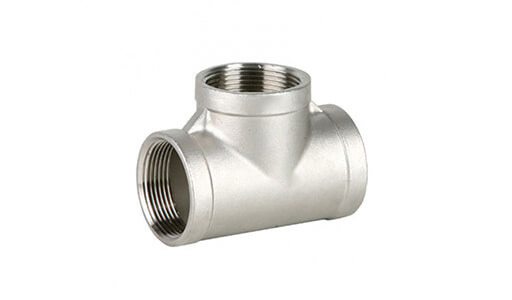
INTRODUCTION:-
Shasan Piping Solution was founded by a group of many years of experienced specialists in product developing, designing, producing management, and quality control. Our Organisation is ISO 9001:2015. We supply only good quality, traceable inspection, and reliable delivery with excellent customer service.
We are professionals and specialize in manufacturing, stockist, importing, and export of Pipe Fittings, Flanges, Fasteners, Instrumentation Fittings, Hammer Union, Valves, Gaskets, Pipes and Tubes, Sheet, Plates, Coils, Bars & Structural Steel Products as per customer’s projects, drawings, standards, and specifications.
The most popular kind of pipe fitting that can be used to combine or divide liquid streams is a threaded tee fitting. The ASTM A182 SS Threaded Tees can be accessed via a female-threaded side outlet and female thread sockets, solvent-weld sockets, or solvent-weld sockets.
Threaded Equal Tees can be used to divert a pipe run, connect pipes of different diameters, or do both. A stock list of forged threaded tees made in various materials, sizes, and wraps is available at Shasan Piping Solution. Additionally, the screwed tee made of alloy steel can also be used to transfer two liquid combinations. Based on their three connections, tees can be classified as equal or unequal in size, with equal tees being the most often produced kind.
DESCRIPTION:-
These threaded tee fittings have undergone additional treatments, one of which includes surface treatments, to improve their outer layer. The threaded tee ASME B16.11 is available in several completions. Typical finishes for the outer layer of the threaded tee include electroplating, nickel plating, white coating, dark cast, gold plating, excited finish, and so forth. While these treatments provide an external advantage to the ASME B16.11 threaded tee features, there should occasionally be an opportunity to further enhance its mechanical qualities, such as by boosting its resistance to and tensile strength of erosion.
Most commonly, cast metal or bronze, forged alloy and carbon steel, or cast dark or flexible iron could be used to make threaded screwed tee fittings. Alternatively, alternative materials such as stainless steel, aluminum, nickel, cast iron, bronze, plastic, elastic, copper, metal, polypropylene, etc. might also be used to make the ASTM A182 SS Threaded Tees. There are three tension ratings available for the ASME B16.11 threaded tee fitting aspects: Class 2000, Class 3000, and Class 6000.
Presumably, the earliest technique for connecting pipe systems is represented by the threaded tee fitting characteristics of ASME B16.11. The ASME B16.11 threaded tee fittings, often called little drag pipework, are mostly used for small pipe diameters, much as socket weld fittings. Little drag pipe is typically defined as piping with an apparent diameter of NPS 2 or less.
SPECIFICATIONS:-
1. Specifications- Forged Threaded equal tee
2. Dimension Specification- ASME 16.11, MSS SP-79, MSS SP-95, 83, 95, 97, BS 3799
3. Threaded equal tee Forged Fittings Thread- NPT, BSPT, BSPP
4. Threaded equal tee FittingsType- DN15-DN1200
5. End- Threaded, Welding, JIC
6. Threaded equal tee Fittings Pressure Rating- Threaded end-2000lb/ 3000lb/ 6000lbs Threaded equal tee, Connection, Welding
7. Bending Radius- R=1D, 2D, 3D, 5D, 6D, 8D, 10D or Custom 8. Threaded equal tee
8. Size Range- 1/8" NB TO 4" NB
9. Manufacturing process- Push, Press, Forge, Cast, etc.
10. Threaded equal tee Test Certificates- EN 10204/3.1B, Raw Materials Certificate, 100% Radiography Test Report, Third Party Inspection Report, etc
11. Origin & Mills - Japanese, Indian, USA, Korean, European, Ukraine, Russian
12. Key markets and industries for Threaded equal tee Fittings- Bitumen upgraders, Heavy oil refineries, Nuclear power (mostly seamless), Petrochemicals and acids.
13. Application - Threaded equal tee To Connect Pipe & Tubes in Petroleum, Power, Chemical, Construction, Gas, Metallurgy, Shipbuilding etc.
BENEFITS:-
High-Quality Products: Threaded equal tee exporters provide products that meet international standards such as ASME 16.11, MSS SP-79, and BS 3799. This ensures that the tees are of superior quality and suitable for various industrial applications.
Wide Range of Options: Exporters offer a diverse range of threaded equal tees, including different sizes, pressure ratings, and materials. This variety allows customers to find the perfect fit for their specific requirements, enhancing flexibility and compatibility with existing systems.
Ease of Installation: Threaded connections offer ease of installation, allowing for quick and hassle-free assembly of piping systems. Threaded equal tees provide a secure and reliable connection without the need for specialized tools or welding, saving time and labor costs during installation.
Versatility: Threaded equal tees are versatile components that can be used in a wide range of industries and applications, including petroleum, chemical, construction, and shipbuilding. Their ability to connect three pipes of equal diameter at right angles makes them essential for branching and distributing fluid flow in piping systems.
Customization Options: Exporters often offer customization options for threaded equal tees, allowing customers to tailor the fittings to their specific needs. Whether it's a particular size, material, or threading requirement, exporters can accommodate various customization requests to meet customer specifications.
Reliable Supply Chain: Exporters ensure a reliable supply chain, ensuring timely delivery of threaded equal tees to customers worldwide. With a robust manufacturing infrastructure and efficient logistics network, exporters can fulfill orders promptly, minimizing downtime and maximizing operational efficiency for businesses.
CONCLUSION:-
In conclusion, threaded equal tee exporters play a crucial role in providing high-quality fittings for industrial piping systems. By offering a wide range of options, ease of installation, versatility, customization capabilities, and a reliable supply chain, exporters empower businesses to optimize their piping systems for enhanced efficiency and performance. Threaded equal tees serve as integral components in various industries, facilitating the distribution and control of fluid flow in piping networks. With a commitment to quality, reliability, and customer satisfaction, threaded equal tee exporters contribute to the success and competitiveness of industries worldwide.
CONTACT US:-
Phone :+91-88797-09191
Phone :+91-22-6651 8642
E-mail : [email protected]
#Threaded Equal Tee Manufacturers#Threaded Equal Tee Suppliers#Threaded Equal Tee Stockists#Threaded Equal Tee Exporters#Threaded Equal Tee Manufacturers in India#Threaded Equal Tee Suppliers in India#Threaded Equal Tee Stockists in India
0 notes